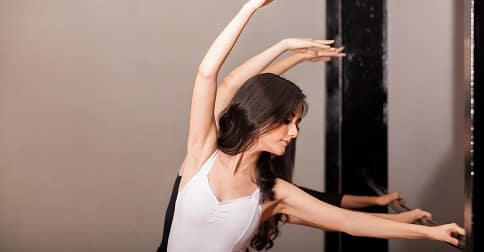So this morning I saw a TV commercial for a local Barre Workout studio.
Interesting, I thought, I hadn’t heard that we had a dedicated barre studio here in the Mid-South. Turns out, there’s a couple. I’m not here to advertise for them, so I’ll leave you to search the studios out if you’re so inclined.
As the name implies, barre workouts are based upon movements derived from ballet dancing – primarily incorporating mat-based bodyweight exercises and (you guessed it) focused muscle movements at the bar that travels along the wall parallel to the floor.
I got more and more curious as the day progressed: what’s the deal with barre workouts? What’s involved? Would they be a beneficial part of your weight loss routine? Let’s explore.
The History
Considering that the basic equipment and many of the moves are based on classic ballet positions, it’s no surprise barre was developed by a ballerina. After injuring her back, Lotte Berk, a German dancer living in London, came up with the idea to combine her dance conditioning routine with her rehabilitative therapy. She opened her first studio in 1959 in her London basement, where famous faces such as Joan Collins and Barbara Streisand regularly came to lift, tuck, and curl.
Lydia Bach, an American student of Berk’s, brought the workout back to the states in 1971, when she opened the first Lotte Berk Method studio in New York City. Since that time, barre has slowly, but steadily grown in popularity and has made a dramatic transition from catering somewhat exclusively to nimble dancer-types to become a choice workout for those of us who could never be mistaken for a prima ballerina.
The Workout
While barre has origins in dance, the rhythmically challenged shouldn’t worry: no tap shoes, leotards, or any fancy footwork are required. Instead, most barre classes follow the same basic structure: You’ll start with a mat-based warm-up full of planks and push-ups, do a series of arm exercises, and continue at the bar with a lower-body section to work your thighs and glutes. Finally, you’ll finish with a series of core-focused moves at the bar or a short session on the mat.
As for gear, the moves are typically bodyweight only, but you can use light hand weights (usually two or three pounds) or resistance bands to level up your arm exercises. For lower-body work, a soft exercise ball is often used to help engage leg muscles. And while most studios recommend wearing socks with sticky grips on the bottom, others let you go barefoot.
So what’s the difference between barre and a typical strength training class? Rather than larger, compound movements (think squats and shoulder presses), you’ll perform tiny, one-inch increments called isometric movements, says Burr Leonard, fitness expert and founder of The Bar Method. That’s why you’ll often hear, “Down an inch, up an inch,” repeated by barre teachers.
The Results
The isometric contractions that make up the bulk of a barre class occur when the muscle tenses without changing length. Think of these movements as the opposite of typical strength training moves which occur when a muscle stretches then shortens (as in a biceps curl). Isometric exercise is a great way to maintain muscle strength.
“What’s wonderful about the one-inch movements is that you can hold a posture and benefit from continuously engaging the muscle, but you also get a mini-recovery with each pulse, so you can stay in the hold longer,” says fitness expert Sadie Lincoln
Isometric movements help isolate specific muscles and you can do more reps with smaller movements like these, which fatigue your muscles in a different way. Plus, isometric movements can help strengthen muscles without straining tendons or ligaments, so there’s less risk of injury compared to more traditional strength training.
You’ll target multiple muscle groups at once.
Generally speaking, barre is a highly efficient workout since you’re doing two to four movements—holding, pulsing, stretching, for example—at a time in each move. For example, in one barre studio I discovered online, you’ll practice the “diamond waterski.” While holding onto the bar with one hand, your legs are in a diamond-shape, heels raised, while the torso is angled (think of a water-skier leaning back). This move mainly targets your quads, but at the same time you’re also challenging the calves, hamstrings, glutes, abs, and upper-back muscles.
You’ll improve your mind-body connection.
The smaller movements in a barre class can bring a new level of awareness to the body that you don’t get in regular strength workouts. In this way, barre can improve muscular activation for frequently underused muscles by strengthening the neuro-muscular (mind-body) connection.
You may lose weight.
The owner of a studio called Bar Method is quoted as saying “We’ve had students who have lost 100 pounds or more doing The Bar Method, but it’s so individual. You just have to be aware of your body and figure out what’s best for you to lose weight.”
Want to learn more about barre workouts, weight training, jogging, calisthenics, or any kind of fitness regimen that may help you on your journey to a healthier body? Call us today or click the Schedule an Appointment button above.

